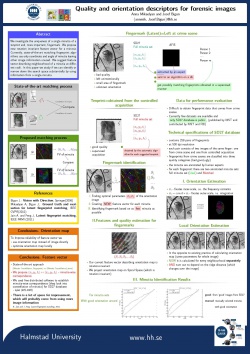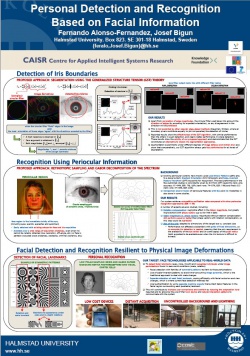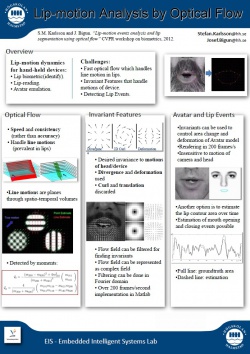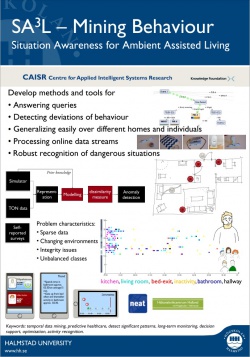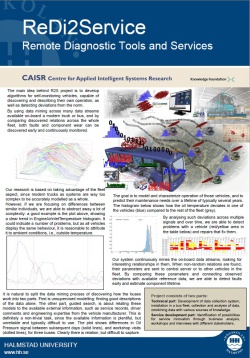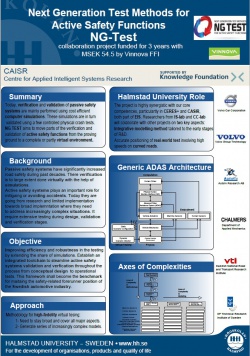Industrial Workshop February 2013
The industrial workshop took place on the 5th of February at the trade centre conference rooms. The goal was to discuss current progress and projects with our industrial partners. In the process, several interesting new ideas for current, as well as future projects emerged. Especially the poster session saw fruitful discussions.
Additionally, we would like to thank all those involved for making the event a social success as well!
Contents
- 1 Posters
- 1.1 Anna Mikaelyan - Quality descriptors for forensic images
- 1.2 Fernando Alonso-Fernandez - Personal Detection and Recognition Based on Facial Information
- 1.3 Antanas Verikas - Measuring Muscle Status and Fatigue in Active People
- 1.4 Stefan Karlsson - Lip-Motion Analysis by Optical Flow
- 1.5 Björn Åstrand - Automatic Inventory and Mapping of Stock - AIMS
- 1.6 Jens Lundström - SA3L - Mining Behaviour
- 1.7 Sławomir Nowaczyk - ReDi2Service Remote Diagnostic Tools and Services
- 1.8 Sławomir Nowaczyk - fuelFEET Fuel FOT Energy Efficient Transport
- 1.9 Sławomir Nowaczyk - InnoMerge & VPMS
- 1.10 Jawad Masood - Next Generation Test Methods for Active Safety Functions NG-Test
Posters
Anna Mikaelyan - Quality descriptors for forensic images
We investigate the uniqueness of a single minutia of a tenprint and, more important, fingermark. We propose new rotation invariant feature vector for a minutia. Currently, state-of-the-art matching fingerprint algorithms use only coordinate and angle of minutia leaving other image information unused. We suggest feature vector describing neighbourhood of a minutia at different radii. In this paper we study if we can identify or narrow down the search space substantially by using information from a fewer minutia.
Fernando Alonso-Fernandez - Personal Detection and Recognition Based on Facial Information
Detection of Iris Boundaries - Reported results show the effectiveness of the GST algorithm
Recognition Using Periocular Information - Our system achieves competitive verification rates compared with other periocular recognition approaches (EER ~15%)
Facial Detection and Recognition Resilient to Physical Image Deformations- To detect facial landmarks (eyes, nose, mouth) and recognize individuals under image perturbations found in real-world conditions (scale, rotation)
Antanas Verikas - Measuring Muscle Status and Fatigue in Active People
An intelligent wearable device equipped with trainable algorithms capable of assessing localized muscle fatige, muscle usage/status profile and performing adcanced post-training analysis as well.
Stefan Karlsson - Lip-Motion Analysis by Optical Flow
Lip-motion dynamics for hand-held devices: Lip biometric(identify), Lip-reading, Avatar emulation
This poster session had an interactive demo "the squiggle". View a video here.
Björn Åstrand - Automatic Inventory and Mapping of Stock - AIMS
An intelligent warehouse environment that autonomously builds a map of articles in a warehouse and relates article identity from the warehouse database with the article’s position (metric) and visual appearance in the warehouse.
Jens Lundström - SA3L - Mining Behaviour
Develop methods and tools for:
answering queries, detecting deviations of behaviour, generalizing over different homes and individuals, processing online data streams, Robust recognition of dangerous situations
Sławomir Nowaczyk - ReDi2Service Remote Diagnostic Tools and Services
Algorithms for self-monitoring vehicles, capable of discovering and describing their own operation, as well as detecting deviations from the norm. Data mining across many data streams available on-board a modern truck or bus. Comparing discovered relations across the whole fleet. Faults and component wear can be discovered early and continuously monitored.
Sławomir Nowaczyk - fuelFEET Fuel FOT Energy Efficient Transport
Explore factors affecting fuel consumption.
Sławomir Nowaczyk - InnoMerge & VPMS
Jawad Masood - Next Generation Test Methods for Active Safety Functions NG-Test
"NG TEST" aims to move parts of the verification and validation of active safety functions from the proving ground to a complete or partly virtual environment.
